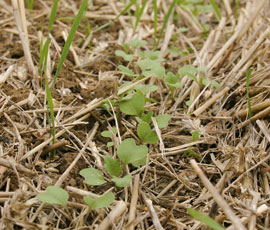Farmers warned of increased phoma risk in oilseed rape

Oilseed rape growers are being warned to be extra vigilant for phoma this season, as drilling delays and continued wet weather heighten disease risk during early crop development.
The disease is already being reported on volunteers, according to ADAS pathologist Peter Gladders. His greatest concern, however, is backward crops with small plants being particularly vulnerable.
“The smaller the plant the easier the disease can spread from leaf to petiole and then to the stem. Plant size this autumn and early risks will depend on how much rain arrives over the next three weeks,” he warned.
Rothamsted Research’s latest update on its oilseed rape disease risk underlined Dr Gladder’s concerns.
“The phoma leaf spot forecast prediction dates are generally seven to 14 days earlier than last year across most of the arable growing region,” said Rothamsted Innovations plant pathologist Neal Evans. “An early onset of the epidemic, combined with backward crops, could prove disastrous to an industry hit hard by what is regarded as a poor harvest.”
“Using a difenoconazole treatment at the first signs of phoma will be important or similarly Sanction (flusilazole) can offer a cheaper alternative.”
Mike Warner, Avocet Agronomy
Suffolk agronomist Mike Warner from Avocet Agronomy highlighted applying the right fungicides will be as vital as ever where more than 10% of plants show symptoms.
“Using a difenoconazole treatment at the first signs of phoma will be important or similarly Sanction (flusilazole) can offer a cheaper alternative.”
Mr Warner also advised a metconazole-based treatment can then be used in helping with the phoma problem as well as having strong growth regulator properties.
However, where phoma is the main problem prothioconazole will tackle it and should last through the winter.
Tim Nicholson from Bayer CropScience also highlights the risk of light leaf spot (LLS) this season. “The wet summer encouraged LLS ahead of harvest and as a result, we can expect to see more coming through this autumn.
“No single variety has good resistance scores for both diseases, so all are vulnerable.”
He added that prothioconazole remains the most effective active against both diseases and recommended its use as the base for all autumn OSR disease control programmes.
See the latest forecast for phoma
Keep up with the latest arable news

